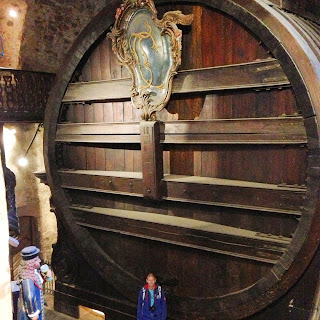A bus ticket to Frankfurt this afternoon, and the likelihood that we won't be returning to Heidelberg anytime soon, if ever, made for good motivation to get out of the hotel in good time this morning, and head back to the historic downtown of Heidelberg. We made mental notes of key attractions along the main thoroughfare of the old town as we hurried back to Heidelberg Castle for a view by day.
The sun was rising behind the castle as we made the courtyard, with the old town stretching out beneath us.
Turns out there is an entry fee to the castle that we appeared to have...missed....last night. 10 Euros to get in and get a tour of the inside of the castle. While we waited for the next tour, we revisited some of the sights we had seen the previous evening.
Our tour of Heidelberg Castle was conducted by a woman named Heidi. No kidding. Prior to exploring the castle rooms, she showed us a model of what the castle once was, prior to the attack that caused its ruins.
Extensive gardens, and a fortress-castle housing the German Wittelsbach family, member of the Prince Electorate. In fact, King Ludwig not only held authority in the selection of the king; further, he operated as the king's deputy, and supreme judge if the king were to be deposed. This truly was a seat of power. The original Heidelberg fortress was built in the twelfth century or earlier, with subsequent building and repair work introducing more modern elements, right until the Renaissance period in the seventeenth century. Subsequently, there has been more destruction than development, with French armies twice storming the castle. The second time, they assured that Heidelberg would no longer be a strategic asset for defense by blowing up the primary defensive towers. The model below shows the castle in its current form.
The "flush" toilets (seen from below - top of the picture) were advanced technology once upon a time. When built, these toilets opened to the dry moat below. Once the terrace where I am standing was built, the toilets were no longer used. Before judging too harshly, I am forced to remember that European train toilets open directly onto the tracks even today.
When the Romans feasted for days on end, they made good use of vomitoria - rooms dedicated to emptying one's stomach in order to have appetite for continued feasting. It is believed that this nondescript opening in the wall of what was once a dining room supplied the same service.
Our tour proceeded through tunnels meant to discretely move defensive armies
...and through finely decorated rooms to impress guests.
A true fortress, much of Heidelberg was built with defense in mind. All spiral staircases turn to the left when going down. In the event of an attack, this would give the defender - presumably on the upper portion of the stairs - full range of motion with his sword, while limiting the abilities of the attacker coming up the stairs at him.
Not all of it was built with defense in mind, though. The largest wine barrel in the world was built in the cellars of Heidelberg to fuel the estimated 2000 litres of wine consumed every day at the castle. As water was often polluted, wine was used for bathing as well as drinking, and due to the low alcohol content, there was no concern about children drinking their fill as well. To reduce the labour of servants going to and from the cellar, this wine pump was installed to pump the wine directly from the barrel into the kitchen adjacent to the main dining hall.
This is not the large wine barrel in the cellar, despite appearances.
This barrel can hold approximately 200 000 litres of wine.
The barrel was filled each year through a wine tax on the local farmers. Though the region is best known for its white wine, both white and red wine (and everything in between) were mixed in this barrel to produce the castle's wine. Today, there is wine-tasting beside this barrel, showcasing the wines of the region. We didn't try it, but I presume the wine for tasting is a little more discriminating than a simple mix of everything available!
As we returned to the town in the valley below, we stopped again to enjoy the magnificent sights of the old town before heading to our Flixbus bound for Frankfurt.
Though my expression belies this, I had done very little tasting in this liqueur shop...
Thankfully the bus-ride to Frankfurt was brief. Any longer and I might have been compelled to dig into my new Heidelberg liqueur! The bus smelled when we got on, which was only exacerbated by a passenger who decided the on-board washroom was an appropriate place to smoke her strong European cigarettes. Throw in some traffic and relentless coughing from the passenger behind us, and I was desperate to disembark in Frankfurt.
While Heidelberg was pretty and picturesque by night, the immediate vicinity of the Frankfurt central station was downright uncomfortable. The streets were littered with homeless panhandlers; not the best place when encumbered by backpacks and luggage! We passed by a hotel we had considered - then decided against - after the reviews warned that the neighbourhood was not safe. I understand the reviewers' perspectives.
Making our way to the front of the central station, the neighbourhood considerably improved, and we found the restaurant WTF (What the Food) for a stellar dinner.
When we found our hotel, it was in a much safer (safer-feeling, at least) and cleaner part of Frankfurt. Our final home-away-from-home in Germany. Bittersweet, as I am looking forward to returning to routine, and to not dragging my luggage around, but I can't say I'm looking forward to ending this vacation!


























No comments:
Post a Comment